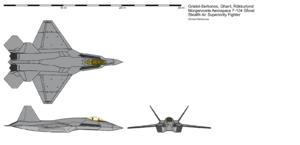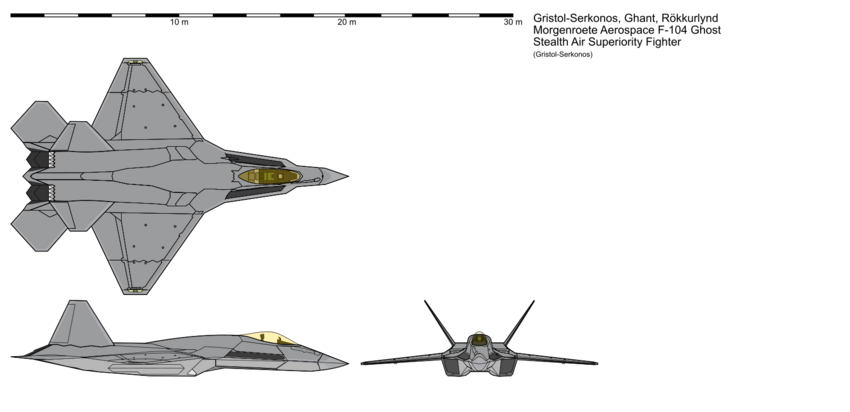Morgenroete F-104 Ghost: Difference between revisions
No edit summary |
No edit summary |
||
| Line 24: | Line 24: | ||
|more users = <!-- Limited to THREE (3) "more users" here (4 total users). List users with {{plainlist}} or {{unbulleted list}}. --> | |more users = <!-- Limited to THREE (3) "more users" here (4 total users). List users with {{plainlist}} or {{unbulleted list}}. --> | ||
|unit cost= $113.1 million per unit | |unit cost= $113.1 million per unit | ||
|program cost= <br> | |||
*$52.5 billion (development) | |||
*$203.5 billion (procurement) | |||
*$470 billion (operations and sustainment) | |||
|produced = 2013-present | |produced = 2013-present | ||
|number built = 150 | |number built = 150 | ||
Revision as of 04:29, 13 May 2023
| Morgenroete F-104 Ghost | |
|---|---|

| |
| Role | Stealth Air Superiority Fighter |
| National origin | |
| Manufacturer | Morgenroete Aerospace |
| Design group | Future Fighter Aircraft Design Consortium
|
| First flight | 18 July 1996 |
| Introduction | 19 September 2015 |
| Status | In service, currently in production |
| Primary user | see Operators |
| Produced | 2013-present |
| Number built | 150 |
| Program cost |
|
| Unit cost |
$113.1 million per unit
|
| Developed from | Morgenroete XF-104 |
The Morgenroete F-104 Ghost is a single-seat, twin-engine, all-weather stealth tactical fighter aircraft. The aircraft was designed primarily as an air superiority fighter, with ground attack, electronic warfare, and signal intelligence capabilities. The aircraft was designated as the F-104 in 2008 and formally entered service in September 2015. The aircraft is currently in service with multiple nations: the Royal Gristo-Serkonan Air Force, air combat units of the Rökkurlynd Armed Forces, and the Ghantish Air Force.
The aircraft was initially a joint development project between the Office of Defence Research, a government research and development agency, and of Morgenroete Skunkworks, the advanced development division of Morgenroete Aerospace. The F-104 aircraft development program began in 1993, however the increasing development costs and the development of new production techniques forced the Gristo-Serkonan government to approach foreign partners to co-develop the aircraft in 2000. The aircraft is designed by the Future Fighter Aircraft Design Consortium, a multinational design group set up by under a cooperation agreement between Gristol-Serkonos, Rökkurlynd, and Ghant. Final manufacturing contracts for the F-104 was awarded to Morgenroete Aerospace, with principal partners GEEM, Marklin-Ashton Aircraft Engines, and Red Rock Defence awarded contracts for manufacturing and developing certain technologies.
Development
Initial Development
The Office of Defence Research was tasked on beginning the research on the fifth generation aircraft with the authorization of the Next Generation Fighter Program by the National Office of Defence in 1990. Morgenroete Aerospace was brought in as a co-development partner in 1991 with Marklin-Ashton Aircraft Engines tasked with developing the powerplant of the aircraft with the SARA's Royal Jet Propulsion Laboratory.
Production and International Participation
Spiraling research and development costs became a concern for the Gristo-Serkonan government following the first flight of the XDF-104 Alpha prototype in 1996. Realizing it would need outside partners to further development the aircraft, the government of Chancellor Jean Watanabe announced it has signed an agreement to co-develop and produce the aircraft with two other countries; Rökkurlynd and Ghant in 2000. The agreement also created the Future Fighter Aircraft Design Consortium, a design group made up of five partners; Morgenroete Skunkworks, the Office of Defence Research of the Gristo-Serkonan government, aerospace engine manufacturer Marklin-Ashton Aircraft Engines, the Ghantish aerospace firm GEEM, and the Rökkurlynd-based defence firm Red Rock Defence.
In the production agreement, Morgenroete Aerospace manufactured the majority of the airframe and final assembly in its production facility in Valois, Gristol-Serkonos. Program partner GEEM provided manufacturing of additional airframe components as well as training systems. Red Rock Defence and Morgenroete Aerospace collaborated on the development of the avionic systems. Engine manufacturer Marklin-Ashton Aircraft Engines participated in the program to produce the powerplant.
The Future Fighter Aircraft Design Consortium's Development Prototype XDF-104 Beta first flew in 2006 following 10 years of delays and cost-overruns. The numerous new technologies in the F-104 resulted in substantial cost overruns and delays. Many capabilities were deferred to post-service upgrades, reducing the initial cost but increasing total program cost. In 2015, the first batch of eight F-104s were delivered to the Royal Gristo-Serkonan Air Force, with deliveries to Rökkurlynd and Ghant coming three months later. So far, a total of 150 F-104s were delivered to partner countries.
Upgrades
In 2021, Morgenroete Aerospace introduced the FGR.12 upgrade block to resolve the deteriorating radiation absorption paint on the nose cone. It also includes improved avionics and electronic countermeasures. These upgrades are expected to take place from 2021 to 2025 for all the F-104 users.
Design
Overview
The F-104 is the third fifth generation fighter to enter military service. The aircraft has as a wing-tail configuration with two vertical stabilizers canted for stealth. Flight control surfaces include leading-edge flaps, flaperons, rudders, and all-moving horizontal tails (stabilators); leading edge root extensions also run forwards to the inlets. Morgenroete Aerospace and its partners collaborated on new production techniques in the development of the F-104. At least 40% of the airframe weight comprise of composites and a significant amount of high-strength materials to withstand stress and heat of sustained supersonic flight.
The F-104's kinematics is competitive with fourth generation fighters due to the ordinance mounted in the aircraft's internal weapons bay, eliminating parasitic drag from external weapons. The aircraft's two Marklin-Ashton J/A-670 augmented afterburning turbofans are capable of top speed of 1.21 with internal payload. The F-104 has a considerably greater combat radius compared most fourth generation aircraft, due to its larger internal fuel storage.
Cockpit
The main display is a 50 by 20 cm panoramic touchscreen panel, which shows flight instruments, stores management, CNI information, and integrated caution and warnings. The information arranged on the main display can be customized by the pilot. Flight and combat information is displayed on a helmet mounted display system. There is a right-hand side stick and throttle hands-on throttle-and-stick system. For life support, an onboard oxygen-generation system is fitted and powered by the aircraft's internal power generation unit, with an auxiliary oxygen bottle and backup oxygen system for emergencies. The ejection seat is mounted on a twin catapult system housed on side rails.
Armament
In order to preserve its stealth characteristics, the F-104 has three internal weapons bays: a large main bay on the bottom of the fuselage with two smaller bays on the sides of the fuselage, located aft of the engine inlets. A small bay for counter measures such as flares are located behind each side bay.
Specifications
General Characteristics
- Crew: 1
- Length: 20.1 m
- Wingspan: 13.56 m
- Height: 5.08 m
- Gross weight: 29,410 kg
- Max takeoff weight: 38,000 kg
- Fuel capacity: 8,200 kg internally, or 12,000 kg with two 2× 2,270 gal tanks
- Powerplant: 2x Marklin-Ashton Aircraft Engines J/A-670 augmented afterburning turbofans, 116 kN dry, 156 kN with afterburner
- Max Speed: Mach 2.25 in altitude
- Mach 1.21 at sea level
- Mach 1.82 supercruise at sea level
- Range: 3000 km with external fuel tanks
- Combat Range: 850 km clean, 185 km in supercruise
Armament
- Guns: 1× 20 mm Royal Armouries RC-716 rotary cannon, 480 rounds
- Air to Air Loadout (Using internal weapons bays)
- 6x AIM-110 BVRAAM
- 2x AIM-112 SRAAM
- Air to Ground Loadout (using internal weapons bays)
- 2x 450 kg DAM-45 bombs or 8x 110 kg PGG-30 bombs
- 2x AIM-110 BVRAAM
- 2x AIM-112 SRAAM
- Hardpoints
- 4x under-wing hardpoints (2 per wing) rated for 2,270 kg.
- 6x internal hardpoints inside main weapons bay rated for 2,270 kg.
Avionics
- Morgenroete AN/APG-779 AESA Radar: 201 km against 1m2 targets on radar.
- Morgenroete AN/AAR-932 Missile Approach Warning System
- Morgenroete AN/ALR-300 Radar Warning Receiver: 460 km detection range
- Red Rock Defence AN/ASQ-476 Electronic Warfare System
- Red Rock Defence AN/AAQ-546 E/O Targeting System
- Red Rock Defence AN/ASQ-922 CNI Suite
Operators
 Gristol-Serkonos
Gristol-Serkonos
- Royal Gristo-Serkonan Air Force: 72 aircraft divided between four squadrons.
- Rökkurlynd
- Rökkurlynd Armed Forces: 30 aircraft divided between its Army and Navy air combat units.
 Ghant
Ghant
- Ghantish Air Force: 48 aircraft divided between four squadrons.
